Background: Among various reactive oxygen species, hydroxyl radicals have the strongest chemical activity, which can damage a wide range of essential biomolecules such as lipids, proteins, and DNA.
Objective: The objective of this study was to investigate the beneficial effects of curcumin on prevention of oxidative damage of biomolecules by hydroxyl radicals generated in in vitro by a Fenton like reaction.
Materials and Methods: We have incubated the serum, plasma and whole blood with H2O2/Cu2+/ Ascorbic acid system for 4 hours at 37 0C and observed the oxidation of biomolecules like albumin, lipids, proteins and DNA.
Results: Curcumin at the concentrations of 50,100 and 200 μmoles, prevented the formation of ischemia modified albumin, MDA, protein carbonyls, oxidized DNA and increased the total antioxidant levels and GSH significantly.
Conclusion: These observations suggest the hydroxyl radical scavenging potentials of curcumin and protective actions to prevent the oxidation of biomolecules by hydroxyl radicals.
Introduction
The aerobic organisms undergo complex interactions during normal metabolism which leads to the release of harmful mediators such as, superoxide anion radical (O2-), singlet oxygen (1O2), hydrogen peroxide (H2O2) and highly reactive hydroxyl radical (OH). These mediators are referred as free radical because of its unpaired electron. In general, OH radical is considered to be a harmful by-product of oxidative metabolism, which can cause molecular damage in living system [1,2]. It shows an average lifetime of 10-9 s and can react with nearly every biomolecule such as nuclear DNA, mitochondrial DNA, proteins and membrane lipids. OH can be artificially generated by the Fenton-reaction [3]. Copper can induce oxidative stress by catalysing the formation of ROS via a Fenton-like reaction [4,5]. The cupric ion (Cu (II)), in the presence of superoxide anion radical or biological reductants such as ascorbic acid or GSH, can be reduced to cuprous ion (Cu (I)) which is capable of catalyzing the formation of reactive hydroxyl radicals through the decomposition of hydrogen peroxide via the Fenton reaction [6,7].
Cu (II) + O2−• → Cu (I) + O2
Cu (I) + H2O2→ Cu (II) + • OH + OH–(Fenton reaction)
The combination of ascorbate, copper, and hydrogen peroxide is an efficient hydroxyl radical generating system called “the Udenfriend system” [8]. Generation of OH radical can ultimately leads to the oxidative damage to biomolecules like proteins, lipids and DNA.
Curcumin (diferuloylmethane) is a naturally occurring yellow pigment isolated from ground rhizomes of the plant Curcuma longa L. (Zingiberaceae) found in south Asia [9]. Curcumin is a potent antioxidant agent and free radical scavenger [10]. Several animal studies have reported hypocholesterolemic, antiatherogenic [11–14], and antiplatelet activity [15], of this compound. Furthermore, in vitro studies of curcumin have shown the anti-inflammatory Action on human vascular cells. Curcumin attenuates inflammatory response of TNF–α stimulated human endothelial cells by interfering with NF-κB [16,17] and is capable of preventing platelet-derived growth factor (PDGF). It also stimulates the migration of vascular smooth muscle cells (VSMCs) by inhibiting MMP-9 activity and expression [18,19].
To our knowledge, there is very little evidence that shows the protective effects of curcumin on hydroxyl radical oxidative damage to biomolecules like proteins, lipids and DNA. Hence, this study is first of this kind, to evaluate the toxic effects of •OH and the protective effects of curcumin, a potent antioxidant in food.
Materials and Methods
Fifty healthy subjects, both male and female within the age group of 18-25y were recruited for the present study, out of which 15 subjects agreed to participate. Blood samples from these subjects were obtained by venipuncture, and EDTA-plasma and serum were separated by centrifugation at 2000 rpm for 10min at 40C. Plasma, serum and whole blood of all the 15 subjects were pooled and aliquots of serum, plasma and whole blood (three replicate experiments per group) were randomly selected for the following incubations for 4h at 37°C. This study consists of five groups, Group 1, Control: Serum, plasma and whole blood samples were incubated with phosphate buffer saline. Group 2, Oxidative stress induced group: In this group, serum, plasma and whole blood samples were incubated with Fenton’s reagent (CuSO4 – 5mm, Ascorbic Acid – 8mm and H2O2 - 3mm) separately. Under in vitro conditions, Cu+ is able to generate the hydroxyl radicals by dismutation of H2O2 according to the Fenton-redox reaction [4,5]. Groups 3, 4 and 5 were curcumin treated groups. In these groups, serum, plasma and whole blood samples were pre incubated with curcumin for one hour at final concentrations of 50,100 and 200 μmoles respectively. Fenton’s reagent was then added to these groups and incubated.
Curcumin was procured from Laila Pharmaceuticals Pvt. Ltd. (with 95% purity synthesized in Laila Impex R&D Centre), L-Ascorbic acid from Hi-Media (Mumbai, India), Dithiothreitol (DTT), 2,4,6-tripyridyl-striazine (TPTZ) and DTNB were obtained from Sigma–Aldrich (St. Louis, MO, USA). All other reagents and chemicals were of analytical grade and of highest purity commercially available.
To determine the oxidative damage caused by hydroxyl radicals to biomolecules, the following tests were performed.
Under oxidative stress, the levels of Ischemia Modified albumin (IMA) elevates in the serum. The levels of IMA were determined by the rapid colorimetric method developed by Bar-Or et al., [20]. The values are expressed in absorbance units (ABSU). Formation of protein carbonyls are the indication of protein oxidation. Serum protein carbonyl (PC) content was spectrophotometrically determined by DNPH assay [21,22]. Lipid peroxidation because of oxidative damage was estimated by the method of Okhawa H, et al., [23]. The total antioxidant capacity of plasma was evaluated by applying the FRAP assay (ferric reducing antioxidant power or ferric reducing ability of plasma) according to the method of Benzie & Strain [24]. Reduced glutathione in blood was estimated by the method of Beutler et al., [25]. Reactive oxygen species can damage the DNA. DNA damage can be determined by the method of Lee et al., [26] with slight modifications. Genomic DNA was isolated by salting out method [27]. DNA was incubated with Fenton’s reagent containing test sample and the final volume of the mixture was raised up to 20μl. The mixture was then incubated for 30min at 37°C and the DNA was analysed on a 1% agarose gel electrophoresis followed by ethidium bromide staining. Finally gel was analysed using uvitec gel document (Cambridge, UK).
Statistical Analysis
The data are expressed as the mean and standard deviation of three parallel measurements. The data were subjected to one-way-analysis of variance (ANOVA). Duncan’s test was used to determine significant differences. p-values ≤ 0.05 were considered as level of significance. The statistical analysis was carried out using SPSS for Windows software (Version 13.0, SPSS, Chicago, IL, USA).
Results
The effect of curcumin on ischemia modified albumin formation is presented in [Table/Fig-1,2]. We have noted that, when serum was exposed to hydroxyl radicals the production of ischemia modified albumin was highly significant (p<0.001) compared to control samples. However, pre-treatment with curcumin effectively prevented the increase in IMA levels significantly. Exposure to •OH radicals increased the degree of MDA formation as compared to the control (p<0.001), pre-treatment with curcumin significantly prevented MDA production [Table/Fig-1,3]. After oxidative stress, the intracellular concentration of protein carbonyls increased when compared with that of the control (p<0.001). Curcumin significantly decreased protein carbonyls content [Table/Fig-1,4]. Hydroxyl radicals significantly decreased the levels of blood GSH and total antioxidant capacity of plasma compared with the control (p<0.001).Curcumin significantly increased the levels of both GSH levels and total antioxidant capacity of plasma [Table/Fig-1,5,6]. The extent of damage to DNA assessed by the relative electrophoretic mobility of the oxidized and curcumin-treated DNAs on 1% agarose gel as compared to native DNA. Lane-2 which is a Fenton’s reagent treated sample showed a maximum fragmentation of DNA as compared to other lanes [Table/Fig-7]. The DNA bands in the 3rd, 4th and 5th lanes corresponding to the band of native DNA with maximum intensity was considered in determining the protection offered by curcumin. Curcumin substantially diminished the DNA damage as evidenced by the intensity determination, and displays almost an equal pattern of DNA protection with higher DNA protecting ability.
Effect of curcumin on hydroxyl radical induced oxidation of biomolecules
| Groups | MDA | PC | IMA | GSH | TAC |
|---|
| Control (Group I) | 12.57 ± 0.95 | 49.38 ± 3.17 | 615.98 ± 29.52 | 0.62 ± 0.20 | 1579.27 ± 46.64 |
| Fenton’s Reagent (Group II) | 20.67 ± 1.17 a*** | 111.46 ± 3.97 a*** | 824.02 ± 21.22 a*** | 0.40 ± 0.05 a** | 1117.28 ± 58.75 a*** |
| Fenton’s Reagent + Cur (50μM) (Group III) | 17.65 ± 1.14 a* | 85.46 ± 4.06 a***, b*** | 781.15 ± 15.95 a*** | 0.46 ± 0.02 a* | 1225.75 ± 37.84 a*** |
| Fenton’s Reagent + Cur (100μM) (Group IV) | 15.55 ± 2.31 b** | 76.52 ± 3.22 a***, b*** | 746.26 ± 30.32 a***,b** | 0.49 ± 0.08 | 1300.02 ± 69.25 a***,b** |
| Fenton’s Reagent + Cur (200μM) (Group V) | 14.42 ± 1.82 b*** | 66.33 ± 2.10 a***, b*** | 721.58 ± 18.57 a***,b*** | 0.54 ± 0.08 | 1425.57 ± 33.13 a*,b*** |
MDA: Malondialdehyde, PC: Protein carbonyls, IMA: ischemia modified albumin, GSH: Reduced glutathione and TAC: Total antioxidant capacity. Values presented are Mean ± S.D. of 3 nos. of samples in each treatment group. Post- Hoc multiple comparison was performed by Duncan’s test. a - Group I compared to Group II, III, IV and V. b - Group II compared to Group III, IV and V. ns- not significant ; *** p<0.001; ** p<0.01; * p<0.05.
Effect of curcumin on the content of reduced glutathione in Hydroxyl radical induced Erythrocytes. The data represent the mean±S.D of three replicates
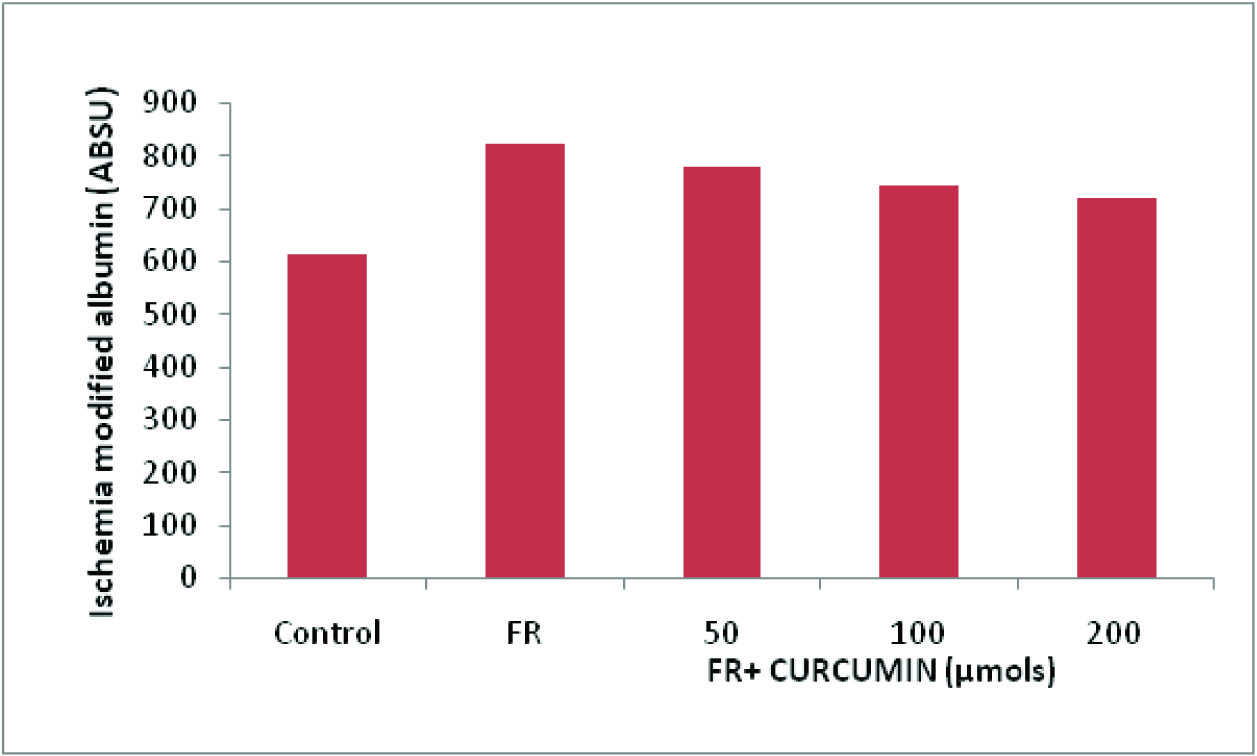
Effect of curcumin on the formation of ischemia modified albumin in hydroxyl radical exposed serum. The data represent the mean±S.D of three replicates
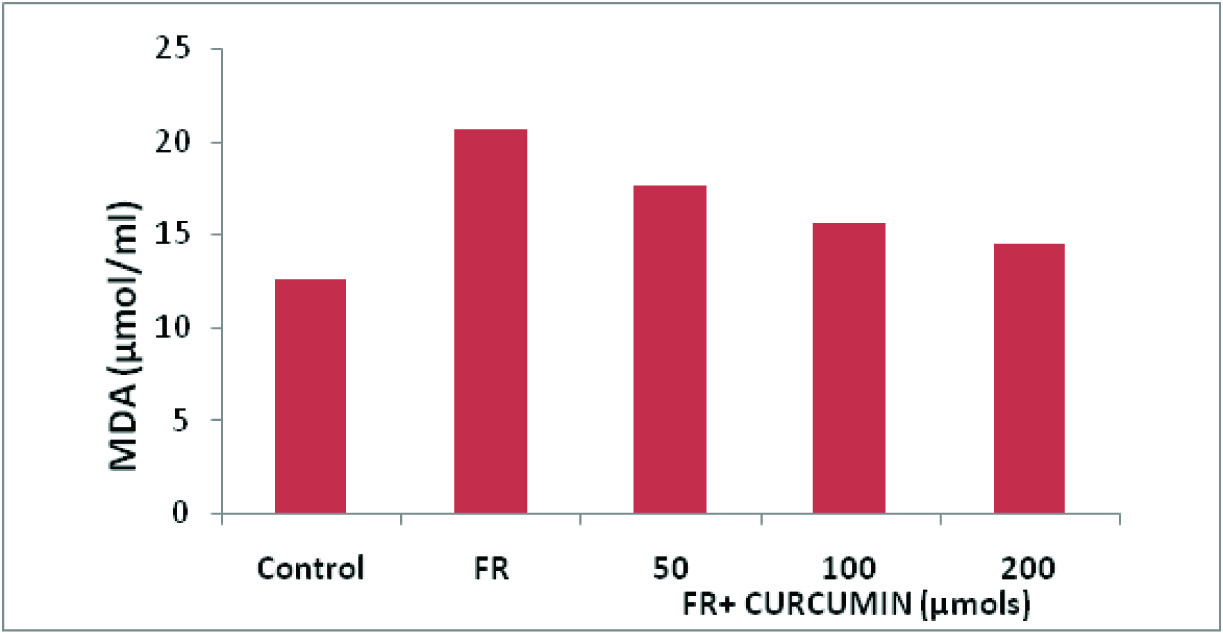
Effect of curcumin on the protein carbonyls formation in hydroxyl radical exposed serum. The data represent the mean±S.D of three replicates
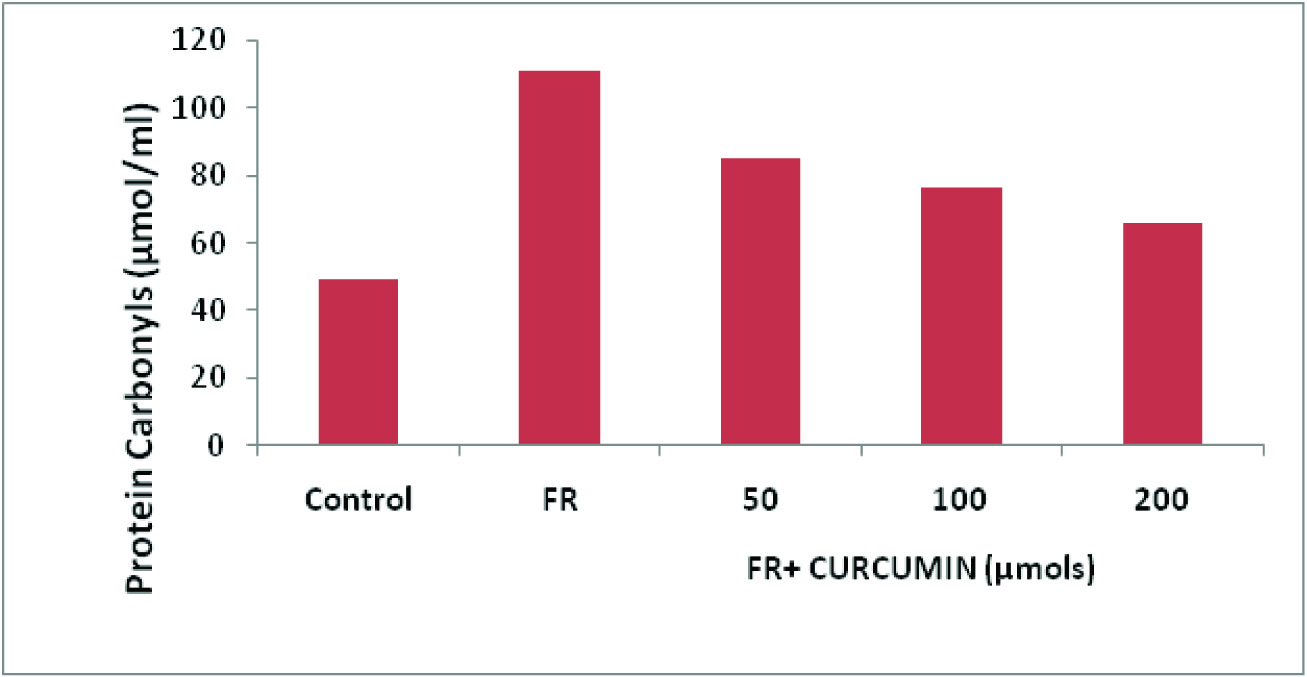
Effect of curcumin on the malondialdehyde formation in hydroxyl radical exposed serum. The data represent the mean±S.D of three replicates
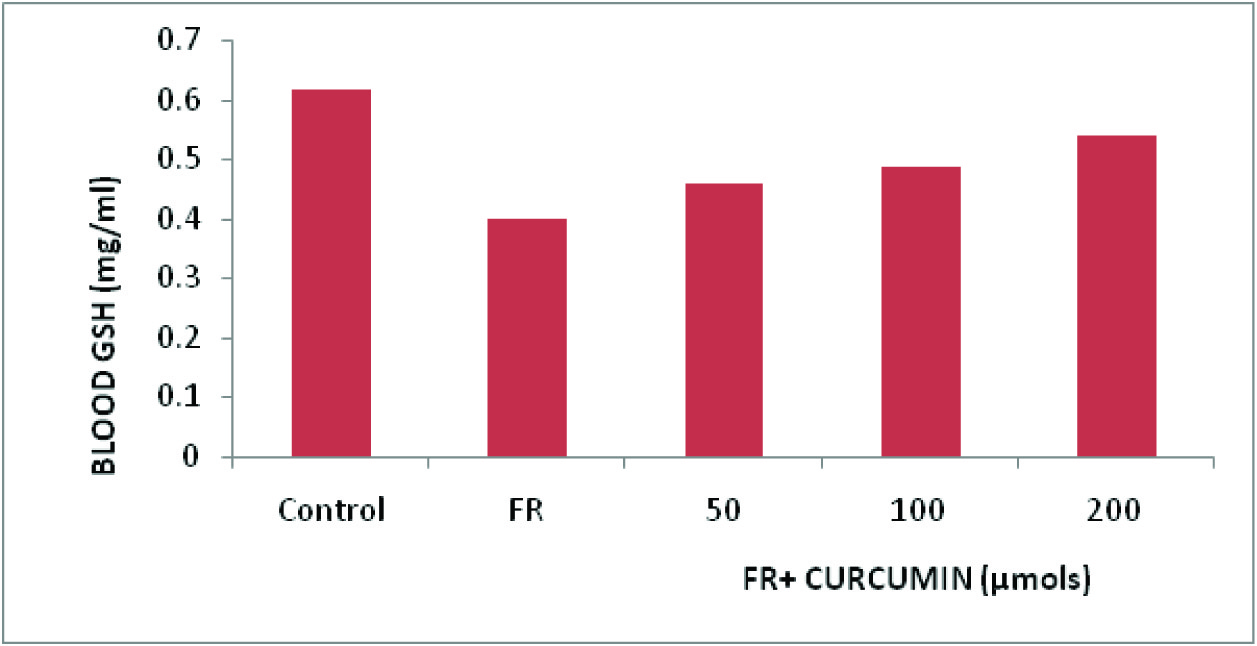
Effects of curcumin on the total anti oxidant capacity of plasma exposed with hydroxyl radical. The data represent the mean±S.D of three replicates
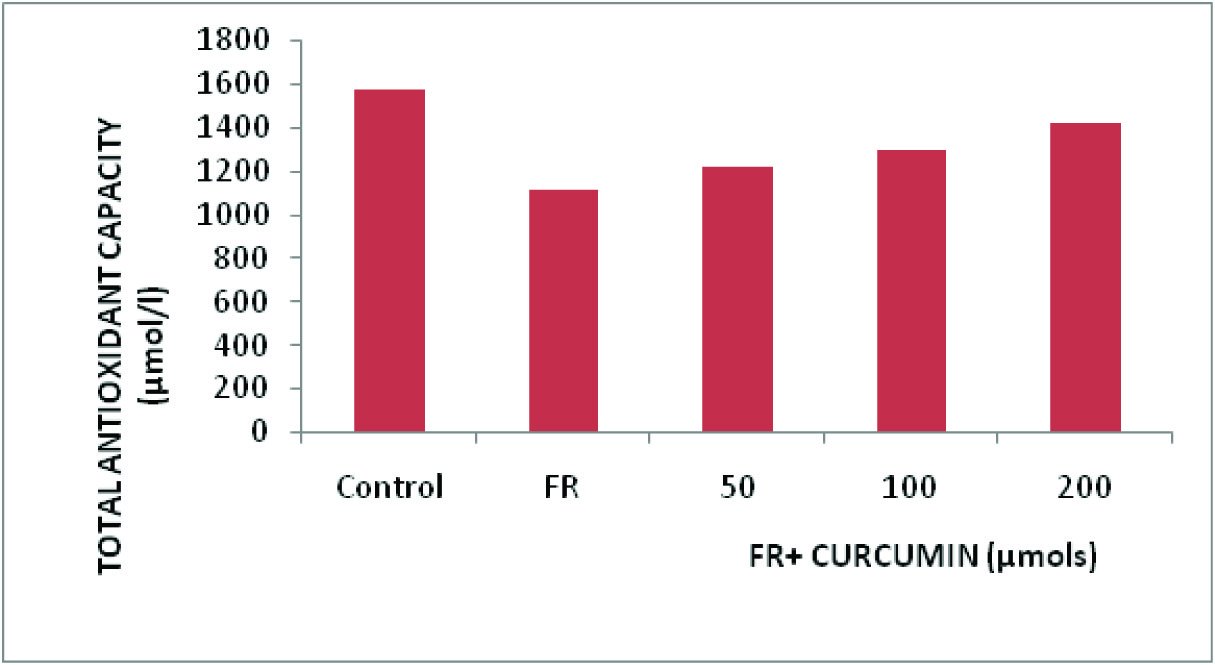
Effect of curcumin on hydroxyl radical induced DNA fragmentation. Lane 1: DNA. Lane 2: DNA + Fenton’s reagent (DNA damage control). Lane 3: DNA + Fenton’s reagent + Curcumin (50 μmole). Lane 4: DNA + Fenton’s reagent + Curcumin (100 μmole) Lane 5: DNA + Fenton’s reagent + Curcumin (200 μmole)

Discussion
Reactive oxygen species (ROS) can cause oxidative damage all types of biomolecules, lipids, proteins and DNA which could be deleterious and concomitant [28]. According to Marx G and Chevion M [29], albumin, the predominant protein in circulation, undergoes site-specific modification in N-terminus, especially of the N Asp– Ala–His–Lys sequence during overproduction of ROS resulting from conditions related to ischemia, hypoxia, acidosis, free radicals [30–33] is unable to bind transition metals like, cobalt [31]. This is the basic mechanism to detect the ischemia modified albumin. Though, the name of the test is ischemia modified albumin (IMA) test, apart from ischemia, levels of IMA elevates in generalized rather than organ- or tissue-specific state of oxidative stress [34]. Our study showed that •OH generation led a rise of IMA concentrations [Table/Fig-1,2]. This is in agreement with the study of Roy D et al., [33], who also found the increase of IMA concentrations with the rise of •OH radical. In our study, curcumin showed significant reduction in the formation of IMA with dose dependent manner [Table/Fig-1, 2].
Lipid peroxidation is a well-established mechanism of oxidative damage caused by ROS, and the measurement of the MDA provides a convenient index of lipid peroxidation [35]. This study provides evidence of an increase MDA by hydroxyl radical induced lipid peroxidation. There was a significant decrease in MDA concentration in the curcumin treated samples due to antioxidative effect of curcumin. Our study data is in accordance with the studies of Eybl V et al., [36], Mahfouz MM et al., [37], Manju M et al.,[38] showing significant antioxidant effect of curcumin on lipid peroxidation.
The process of protein oxidation introduces new functional groups such as hydroxyls and carbonyls group, which were generated by many different mechanisms, this can indicate the degree of ROS mediated protein oxidation contribute to altered function and turnover. The outcomes of protein oxidation are fragmentation, cross-linking and unfolding. This may accelerate or hinder proteolytic and proteosome-mediated turnover, according to the severity of oxidative damage [39,40]. In the present study, protein oxidation was significantly inhibited by curcumin. This is in good agreement with the reports of Dkhar P et al., [41], who stated the effective antioxidant effect of curcumin on age induced oxidative stress in mice cerebral hemispheres and Kolodziejczyk J et al., [42], who illustrated the peroxynitrite (ONOO (-) induced oxidative stress in human blood platelets and plasma.
ROS can rapidly be removed by non-enzymatic and enzymatic antioxidants that prevent their harmful effects and maintain a prooxidant/oxidant balance [43]. Glutathione (GSH) is a multifunctional intracellular non-enzymatic antioxidant. It is considered to be the major thiol-disulphide redox buffer of the cell. GSH protects cells against apoptosis, the protective role originates from multifactorial mechanisms that involve detoxification and modulation of cellular redox state and the subsequent redox-sensitive cell-signalling pathways and interaction with pro- and anti-apoptotic signals [44]. The current study demonstrated that curcumin maintained GSH content, which was depressed following hydroxyl radical exposure [Table/Fig-1,5].This was in agreement with Biswas SK et al., [45], who stated that curcumin can induce glutathione synthesis and increase the level of GSH and glutamylcysteine ligase catalytic subunit mRNA expression in oxidant and TNF α treated cells. The results in this study indicates that, curcumin may have profound effects on cellular redox control and similar to the studies of Eybl V et al., [36] and Sehgal A et al., [46].
In our study, the total anti oxidant capacity of plasma exposed to hydroxyl radicals was evaluated by FRAP Assay. Principally, FRAP assay treats the antioxidants in the sample as reductant in a redox linked colorimetric reaction. Antioxidant compounds which act as reducing agent exert their effect by donating hydrogen atom to ferric complex and thus break the radical chain reaction [24]. The results showed the total anti-oxidant capacity of plasma exposed to hydroxyl radical increased when treated with curcumin in 3rd, 4th and 5th groups [Table/Fig-1,6]. This is in accordance with the studies of Weber WM et al., [47] and Bhullar KS et al., [48], who also estimated the total anti oxidant capacity of curcumin and its analogs.
It is stated that, hydroxyl radicals generates as result of Fenton chemistry, cause oxidative damage which includes single and double strand breaks in DNA, base modification, cross linking of DNA with proteins and fragmentation of genomic DNA. So, tissue uncovered to hydroxyl radicals may lead to cancer, cardiovascular diseases, cataract and neurological disorders [49]. DNA fragmentation has been utilized as a characteristic feature of apoptosis [50]. H2O2 /Cu2+/ ascorbic acid system produced very extensive base modification in DNA. Thus there is a greater ability of cu2+ ions, as compared with fe3+ ions, to promote DNA damage via oxygen- derived species [51]. Cu2+ ions bind to the DNA and cause damage by generating OH in site-specific reactions [52]. In our study, curcumin prevented the fragmentation of DNA by quenching the hydroxyl radicals efficiently in 3rd, 4th and 5th groups [Table/Fig-7]. Similar studies were conducted by Ryu Ar et al., [53], Madkour NK [54] Zhu YG et al., [55], Chan WH et al., [56], who stated that curcumin can also inhibit the oxidative DNA damage by Chrysotile, Lambda cyhalothrin, tert-butyl hydroperoxide (t-BHP) and Methylglyoxal respectively.
Curcumin is one of the few anti-oxidants that possess both phenolic hydroxy and β -diketone groups in one molecule. Its unique conjugated structure includes two phenols and an enol form of a β- diketone. Antioxidant mechanisms of curcumin have been studied by laser flash photolysis and pulse radiolysis, and it was found that the keto-enol-enolate equilibrium of the heptadienone moiety of curcumin determined its physicochemical and antioxidant properties [57,58]. Hence overall antioxidant effect of curcumin on the oxidative stress induced by aerobic metabolism has proved to be effective.
Conclusion
The present study suggested that curcumin has the ability to protect the biomolecules like proteins, lipids and DNA from hydroxyl radical oxidation. These results demonstrate that exposure to •OH in serum and plasma is a good experimental model for studying ROS - induced toxicity and evaluating the protective effects of various agents. Since this study was done in invitro, in future in vivo studies are needed to establish the •OH radical scavenging potential of curcumin.
MDA: Malondialdehyde, PC: Protein carbonyls, IMA: ischemia modified albumin, GSH: Reduced glutathione and TAC: Total antioxidant capacity. Values presented are Mean ± S.D. of 3 nos. of samples in each treatment group. Post- Hoc multiple comparison was performed by Duncan’s test. a - Group I compared to Group II, III, IV and V. b - Group II compared to Group III, IV and V. ns- not significant ; *** p<0.001; ** p<0.01; * p<0.05.
[1]. Livingstone DR, Contaminant-stimulated reactive oxygen species production and oxidative damage in aquatic organisms Mar Pollut Bull 2001 42:656-66. [Google Scholar]
[2]. Cheng FC, Jen JF, Tsai TH, Hydroxyl radical in living systems and its separation methodsJ Chromatogr B 2002 781:481-96. [Google Scholar]
[3]. Aoyagi S, Yamazaki M, Miyasaka T, Clarification of enhanced hydroxyl radical production in fenton reaction with ATP/ADP based on luminol chemiluminescence J Chem Eng Jpn 2001 34:956-59. [Google Scholar]
[4]. Prousek J, Fenton chemistry in biology and medicine Pure Appl Chem 2007 79:2325-38. [Google Scholar]
[5]. Liochev SI, Fridovich I, The Haber-Weiss cycle-70 years later: an alternative view Redox Rep 2002 7:55-57. [Google Scholar]
[6]. Aruoma OI, Halliwell B, Gajewski E, Dizdaroglu M, Copper-ion-dependent damage to the bases in DNA in the presence of hydrogen peroxide Biochem J 1991 273:601-04. [Google Scholar]
[7]. Barbusinski K, Fenton reaction—controversy concerning the chemistry Ecol Chem Eng 2009 16:347-58. [Google Scholar]
[8]. Udenfriend S, Clark CT, Axelrod J, Brodie BB, Ascorbic acid in aromatic hydroxylation. A model system for aromatic hydroxylation J Biol Chem 1954 208:731-39. [Google Scholar]
[9]. Lodha R, Bagga A, Traditional Indian systems of medicine Ann Acad Med Singapore 2000 29(1):37-41. [Google Scholar]
[10]. Fujisawa S, Atsumi T, Ishihara M, Kadoma Y, Cytotoxicity, ros-generation activity and radical-scavenging activity of curcumin and related compounds Anticancer Res 2004 24(2B):563-69. [Google Scholar]
[11]. Manjunatha H, Srinivasan K, Hypolipidemic and antioxidant effects of curcumin and capsaicin in high-fat-fed rats Can J Physiol Pharmacol 2007 85:588-96. [Google Scholar]
[12]. Seo KI, Choi MS, Jung UJ, Kim HJ, Yeo J, Jeon SM, Effect of curcumin supplementation on blood glucose, plasma insulin, and glucose homeostasis related enzyme activities in diabetic db/db mice Mol Nutr Food Res 2008 52:995-1004. [Google Scholar]
[13]. Shin SK, Ha TY, McGregor RA, Choi MS, Long-term curcumin administration protects against atherosclerosis via hepatic regulation of lipoprotein cholesterol metabolism Mol Nutr Food Res 2011 55:1829-40. [Google Scholar]
[14]. Olszanecki R, Jawien J, Gajda M, Mateuszuk L, Gebska A, Korabiowska M, Effect of curcumin on atherosclerosis in apoE/LDLR-double knockout mice Physiol Pharmacol 2005 56:627-35. [Google Scholar]
[15]. Prakash P, Misra A, Surin WR, Jain M, Bhatta RS, Pal R, Anti-platelet effects of Curcuma oil in experimental models of myocardial ischemia-reperfusion and thrombosis Thromb Res 2010 127:111-18. [Google Scholar]
[16]. Kim YS, Ahn Y, Hong MH, Joo SY, Kim KH, Sohn IS, Curcumin attenuates inflammatory responses of TNF-alpha-stimulated human endothelial cells J Cardiovasc Pharmacol 2007 50:41-49. [Google Scholar]
[17]. Panicker SR, Kartha CC, Curcumin attenuates glucose induced monocyte chemo attractant protein-1 synthesis in aortic endothelial cells by modulating the nuclear factor kappaB pathway Pharmacology 2010 85:18-26. [Google Scholar]
[18]. Yang X, Thomas DP, Zhang X, Culver BW, Alexander BM, Murdoch WJ, Curcumin inhibits platelet-derived growth factor-stimulated vascular smooth muscle cell function and injury-induced neointima formation Arterioscler Thromb Vasc Biol 2006 26:85-90. [Google Scholar]
[19]. Yu YM, Lin HC, Curcumin prevents human aortic smooth muscle cells migration by inhibiting of MMP-9 expression Nutr Metab Cardiovasc Dis 2010 20:125-32. [Google Scholar]
[20]. Bar-Or D, Lau E, Winkler JV, A novel assay for cobalt-albumin binding and its potential as a marker for myocardial ischemia - a preliminary report J Emerg Med 2000 19:311-15. [Google Scholar]
[21]. Levine RL, Williams JA, Stadtman ER, Shacter E, Carbonyl assays for determination of oxidatively modified proteins Methods Enzymol 1994 233:346-57. [Google Scholar]
[22]. Reznick AZ, Packer L, Oxidative damage to proteins: spectrophotometric method for carbonyl assay Methods Enzymol 1994 233:357-63. [Google Scholar]
[23]. Okhawa H, Oshishi N, Yagi K, Assay for lipid peroxides in animal tissues by thiobarbituric acid reaction Anal Biochem 1979 95:351-58. [Google Scholar]
[24]. Benzie IF, Strain JJ, The ferric reducing ability of plasma (FRAP) as a measure of “antioxidant power”: the FRAP assay Anal Biochem 1996 239:70-76. [Google Scholar]
[25]. Beutler E, Dunn O, Kelly BM, Improved method for the determination of blood glutathione J Lab Clin Med 1963 65:882-88. [Google Scholar]
[26]. Lee J, Kim HR, Kim J, Jang YS, Antioxidant property of an ethanol extract of the stem of Opuntia ficus-indica var Saboten. J Agric Food Chem 2002 50:6490-96. [Google Scholar]
[27]. Miller SA, Dykes DD, Polesky HF, A Simple Salting out Procedure for Extracting DNA from Human Nucleated Cells Nucleic Acids Res 1988 16:1215 [Google Scholar]
[28]. Nakazawa H, Genka C, Fujishima M, Pathological aspects of active oxygens/free radicals Jpn J Physio 1996 46:15-32. [Google Scholar]
[29]. Marx G, Chevion M, Site-specific modification of albumin by free radicals: reaction with copper (II) and ascorbate Biochem J 1986 236:397-400. [Google Scholar]
[30]. Chan B, Dodsworth N, Woodrow J, Tucker A, Harris R, Site-specific N-terminal auto-degradation of human serum albumin Eur J Biochem 1995 227:524-28. [Google Scholar]
[31]. Bar-Or D, Curtis G, Rao N, Bampos N, Lau E, Characterization of the Co(2+) and Ni(2+) binding amino-acid residues of the N-terminus of human albumin Eur J Biochem 2001 268:42-47. [Google Scholar]
[32]. Roy D, Quiles J, Gaze DC, Collinson P, Kaski JC, Baxter GF, Role of reactive oxygen species on the formation of the novel diagnostic marker ischaemia modified albumin Heart 2006 92:113-14. [Google Scholar]
[33]. Sbarouni E, Georgiadou P, Voudris V, Ischemia modified albumin changes — review and clinical implications Clin Chem Lab Med 2011 49:177-84. [Google Scholar]
[34]. Borderie D, Allanore Y, Meune C, Devaux JY, Ekindjian OG, Kahan A, High ischemia modified albumin concentration reflects oxidative stress but not myocardial involvement in systemic sclerosis Clin Chem 2004 50:2190-93. [Google Scholar]
[35]. Nielsen F, Mikkelsen BB, Nielsen JB, Andersen HL, Grandjean P, Plasma malondialdehyde as a biomarker for oxidative stress: reference interval and effects of life style factors Clin Chem 1997 43:1209-14. [Google Scholar]
[36]. Eybl V, Kotyzová D, Lešetický L, Bludovská M, Koutenský J, The influence of curcumin and manganese complex of curcumin on cadmium-induced oxidative damage and trace elements status in tissues of mice J Appl Toxicol 2006 26:207-12. [Google Scholar]
[37]. Mahfouz MM, Zhou Q, Kummerow FA, Effect of curcumin on LDL oxidation in vitro, and lipid peroxidation and antioxidant enzymes in cholesterol fed rabbits Int J Vitam Nutr Res 2011 81:378-91. [Google Scholar]
[38]. Manju M, Sherin TG, Rajeesha KN, Sreejith P, Rajasekharan KN, Oommen OV, Curcumin and its derivatives prevent hepatocyte lipid peroxidation in Anabas testudineus J Fish Biol 2008 73:1701-13. [Google Scholar]
[39]. Le-Donne I, Rossi R, Giustarini D, Milzani A, Colombo R, Protein carbonyl groups as biomarkers of oxidative stress Clin Chim Acta 2003 329(1–2):23-38. [Google Scholar]
[40]. Berlett BS, Stadtman ER, Protein oxidation in aging, disease, and oxidative stress J Biol Chem 1997 272(33):20313-16. [Google Scholar]
[41]. Dkhar P, Sharma R, Effect of dimethylsulphoxide and curcumin on protein carbonyls and reactive oxygen species of cerebral hemispheres of mice as a function of age Int J Dev Neurosci 2010 28:351-57. [Google Scholar]
[42]. Kolodziejczyk J, Olas B, Saluk-Juszczak J, Wachowicz B, Antioxidative properties of curcumin in the protection of blood platelets against oxidative stress in vitro Platelets 2011 22:270-76. [Google Scholar]
[43]. Svobodova A, Walterova D, Psotova J, Influence of silymarin and its flavonolignans on H2O2-induced oxidative stress in human keratinocytes and mouse fibroblasts Burns 2006 32:973-79. [Google Scholar]
[44]. Masella R, Benedetto RD, Vari R, Filesi C, Giovannini C, Novel mechanism of natural antioxidants compounds in biological system: involvement of glutathione related enzymes J Nutr Biochem 2005 16:577-86. [Google Scholar]
[45]. Biswas SK, McClure D, Jimenez LA, Megson IL, Rahman I, Curcumin induces glutathione biosynthesis and inhibits NF-kappaB activation and interleukin-8 release in alveolar epithelial cells: mechanism of free radical scavenging activity Antioxid Redox Signal 2005 7:32-41. [Google Scholar]
[46]. Sehgal A, Kumar M, Jain M, Dhawan DK, Piperine as an adjuvant increases the efficacy of curcumin in mitigating benzo(a)pyrene toxicity Hum Exp Toxicol 2012 31:473-82. [Google Scholar]
[47]. Weber WM, Hunsaker LA, Abcouwer SF, Deck LM, Vander Jagt DL, Anti-oxidant activities of curcumin and related enones Bioorg Med Chem 2005 13:3811-20. [Google Scholar]
[48]. Bhullar KS, Jha A, Youssef D, Rupasinghe HPV, Curcumin and Its Carbocyclic Analogs: Structure-Activity in Relation to Antioxidant and Selected Biological Properties Molecules 2013 18(5):5389-404. [Google Scholar]
[49]. Cadet J, Berger M, Douki T, Ravanat JL, Oxidative damage to DNA: formation, measurement, and biological significance Rev Physiol Biochem Pharmacol 1997 131:1-87. [Google Scholar]
[50]. Chai J, Xiong Q, Zhang P, Zheng R, Peng J, Jiang S, Induction of Ca2+ signal mediated apoptosis and alteration of IP3R1 and SERCA1 expression levels by stress hormone in differentiating C2C12 myoblasts Gen Comp Endocr 2010 166:241-49. [Google Scholar]
[51]. Stoewe R, Prütz WA, Copper-catalyzed DNA damage by ascorbate and hydrogen peroxide: kinetics and yield Free Radic Biol Med 1987 3:97-105. [Google Scholar]
[52]. Halliwell B, Gutteridge JMC, Role of free radicals and catalytic metal ions in human disease: an overview Methods in Enzymology 1990 186:1-85. [Google Scholar]
[53]. Ryu Ar, Kim JJ, Lee MY, The Inhibitory Effect of Phytochemicals on the Oxidative DNA Damage in Lymphocytes by Chrysotile J Appl Biol Chem 2012 55:179-84. [Google Scholar]
[54]. Madkour NK, Protective effect of curcumin on oxidative stress and DNA fragmentation against lambda cyhalothrin-induced liver damage in rats J App Pharm Sci 2012 2(12):76-81. [Google Scholar]
[55]. Zhu YG, Chen XC, Chen ZZ, Zeng YQ, Shi GB, Su YH, Curcumin protects mitochondria from oxidative damage and attenuates apoptosis in cortical neurons Acta Pharmacol Sin 2004 25:1606-12. [Google Scholar]
[56]. Chan WH, Wu HJ, Protective effects of curcumin on methylglyoxal-induced oxidative DNA damage and cell injury in human mononuclear cells Acta Pharmacol Sin 2006 27(9):1192-98. [Google Scholar]
[57]. Jovanovic SV, Steenken S, Boone CW, H-atom transfer is a preferred antioxidant mechanism of curcumin J Am Chem Soc 1999 121:9677-81. [Google Scholar]
[58]. Priyadarsini KI, Maity DK, Naik GH, Sudheer Kumar M, Unnikrishan MK, Satav JG, Role of phenolic O-H and methylene hydrogen on the free radical reactions and antioxidant activity of curcumin Free Radic Biol Med 2003 35:475-84. [Google Scholar]